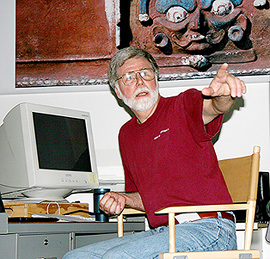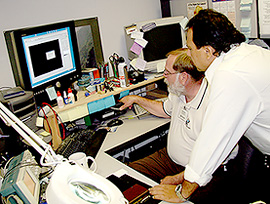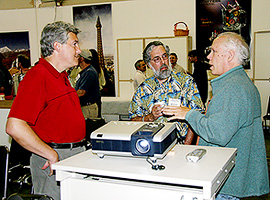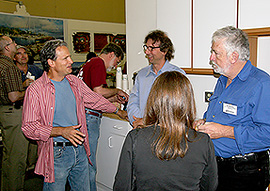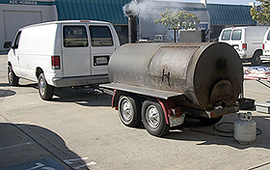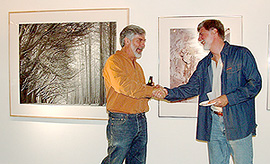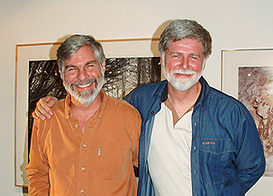
|
BETTER LIGHT'S 4th "Almost Annual" OWNERS CONFERENCE
Location: Better Light Offices & Studio, San Carlos, California |
|||||||||||||||||||||||||||
|
Education Matters…
Over the years the photographic applications where the Better Light scanning back is used has grown from primarily commercial product photography and art reproduction, to now include architecture, landscape, panoramic, forensic, scientific and industrial applications. As digital capture has become more of the norm in the photography industry, Better Light scanning backs have taken their rightful place as the true large format digital imaging system. The exceptional image quality, large file sizes, control of color and tone levels, use of the 4x5 view camera format are some of the reasons why photographers all over the world are selecting Better Light for their high-end digital photography. Better Light is a unique company in today’s world, holding customer service and product reliability as a business priority. Everyone in the company genuinely cares about the success of their customers. The mutual respect and the pursuit of the highest quality digital imaging has formed a bond between Better Light and the scanning back owners like no other in the photography industry. Educational programs are growing in importance at Better Light, and the Owners’ Conferences have been one of the most successful means of sharing the wealth of knowledge of staff and our talented owners. Additional seminars, and a continuing development of the Better Light website will further the efforts to improve the successful operation of the scanning back, as well as provide ideas on other applications and procedures that can stimulate the creativity and business success of the owners. Meeting Emphasizes Diversity of Scan Back Applications Welcomed with beautiful spring weather in Northern California, nearly 70 Better Light scanning back owners and staff met at the San Carlos Better Light offices June 2-3 for two days packed with mini-seminars and idea sharing. After missing a year in 2004, the Owners’ Conference was announced for this past June, and registrations came in faster than any previous year. Not only has the customer base grown, but also the reputation of the high-value of this Conference is spreading. A number of owners have attended several of the previous sessions. It didn't take long to fill the fifty seats that were originally planned, and as the event grew closer, more seats were added to accommodate the demand. Mike Collette, president of Better Light, established the Owners’ Conference as an educational opportunity…not a for-profit event. The two-day seminar is priced at $125 and includes meals, highlighted by a Thursday evening Barbecue dinner. “We want to pass on some new ideas and technical knowledge to our owners with this program, and we really love getting a chance to get to know the person from the other side of the phone. It is a great experience for all of us – and, we probably learn more from the owners than they learn from us”, Collette added. The objective of this year’s Conference was to provide more information on how to optimize the use of the scanning back, but also to help those in attendance discover new ways to earn money in this difficult photographic market. It is all too easy to get caught up in your own specialty and not look “outside of the box”. The programming this year was more diverse than ever before, and reflected the wide range of specialties within the attendees. This year’s group included photographers that imaged everything from ancient antiquities to ice cores for scientific study. A high percentage of the group were involved in art reproduction, for local artists, museums or libraries. A Marriott Fairfield Inn and Suites nearby was our “headquarters” hotel and hosted a welcome reception on Wednesday evening prior to the conference. This provided an opportunity for the attendees to meet each other and arrange carpools or van transportation to the studio in the morning. We were not expecting the immediate comradery that developed with small group discussions going on for hours. Early the next morning, greeted by bagels, pastries and coffee, the group began to gather for two full days of programming. After initial introductions, Mike Collette discussed some of the technical reasons that made digital capture, especially the Better Light scanning back, capable of exceeding the quality of film. Understanding the strengths of the scanning back gives a deeper appreciation of the equipment and can support efforts to gain new customers with a superior digital capture system. J. Michael Sullivan of Massachusetts was at the podium after a coffee break, explaining how he uses the unique Infrared sensitivity of the Better Light scanning back to create beautiful abstract art landscapes. He showed a number of images from his IR-land series from Ireland that is featured on this website at: http://www.betterlight.com/Michael_Sullivan.asp. After lunch, there is no better way of getting people fired up than to bring on “The Rev”, Michael Richardson from Southern California. He purchased the scan back about seven years ago. He has claimed that the Better Light “changed his life forever”, and has become one of Better Light’s most enthusiastic evangelists. As a versatile commercial photographer, Richardson has challenged the scanning back in some of the toughest situations, including scanning from the top of a fully extended scissor lift. He continues to create photos that were not supposed to be able to be made with a scanning back. His presentation was a mix of examples of his work, how his business profitability has dramatically improved because of the scanning back, and some insights from his recent tests with the larger megapixel single-shot cameras…and the Better Light still “kicks A$$”, as Richardson proudly boasts. The afternoon session included a program by Geoff Hargreaves of the National Ice Core Lab, part of the US Geographical Survey in Denver, Colorado. The Ice Core Lab has adapted the Better Light panoramic motor system to drive a table holding a one-meter long core of ice past the fixed CCD of the scanning back, creating a seamless panoramic-like image. The cores must be photographed at a constant oblique angle in order to show the light and dark rings that are visible in the ice. The size, spacing and tone of the rings can determine a time line of geological events. The U.S. National Ice Core Laboratory is a facility for storing and studying ice cores recovered from the polar regions of the world. It provides scientists with the capability to conduct examinations and measurements on ice cores. Ice cores contain an abundance of climate information -- more so than any other natural recorder of climate such as tree rings or sediment layers. An ice core from the right site can contain an uninterrupted, detailed climate record extending back hundreds of thousands of years. The obstacle Hargreaves faces is that his work has to be done in the freezer…the computer, scanning back and other equipment (and the photographer) needs to be insulated, heated and ventilated to maintain constant, functional temperatures. What started to be a presentation on the uniqueness of the scanning back application, turned into a fascinating discussion about the scientific and historic value of this work…a surprise highlight to the conference. Returning to the technical side, the next presentation by Robin Myers and Dave Christensen covered some of the aspects of lighting for fine art reproduction. “Even lighting” has been a hot topic for years with photographers expressing their frustrations with the search for perfect lighting. The tools within Better Light’s ViewFinder software have made this quest even more frustrating since we can now see variations with Tone Zones and the Spot Meter down to a single RGB unit. Christensen began with an introduction of the new NorthLight HID Copy Lights he created to improve illumination of artwork (for more information: http://www.betterlight.com/hid_copylights.html). These light will provide higher light levels, more even illumination, minimal UV and heat from Infrared, all at very low power consumption when compared to other tungsten, fluorescent or HMI options. Lenses and camera f-stop setting are also factors in the even illumination across the copyboard. Christensen showed examples of a number of lenses and varied aperture openings with the aid of the color-posterized Tone Zone tool in ViewFinder to show how the light falls off from edge to edge of the imaging area. It is important to understand that many factors are involved in the art repro process, and each contributes a little to make it nearly impossible to get “perfect” illumination. Robin Myers continued with the importance of even lighting on the color chart that is used to create a profile. Uneven light on the color patches will provide false readings to the profile software and create additional problems in contrast, density and color results in the final output. Myers also reviewed some of the software that has recently been on the market to correct for uneven light. At this time, these programs do not do a job equal to the quality expectations of the Better Light reprographic users. Bill Atkinson of Portola Valley, CA gave a short presentation on a technique that he had developed using an additional 16-bit capture of a white card and several Photoshop steps to adjust for the light falloff. This type of post-capture correction seems to be the only way to conquer the limitations of technology, physics and optics at the moment. (Imagine what we “got away with” when using film!) As the end of the day’s presentations approached, the aroma of the charcoal grill outside was drifting into the studio. It was time for a delicious barbecue dinner with chicken, ribs, and all the fixings. The weather was great, and you could find little groups of people sitting outside and all around the studio, enjoying the food and continuing on with discussions of all aspects of photography, art and business. In years past we found people stayed around after dinner asking more questions and working with the equipment, so this year we offered three breakout sessions to cover some specific topics of interest. One group continued discussions on art repro lighting, others gathered around Mike Collette to talk about the Pano/WideView adapter and the opportunities of panoramic imaging, and another group went back to the basics with discussions on using the ViewFinder Software. The next morning began with an overview of the new changes that will be incorporated into the next release of the ViewFinder software and some tips related to the use of the functions and tools in the program. The group was reminded that each Viewfinder Software CD (shipped with the scanning back) included a tutorial on the basic steps to a successful scan. This low-res version of the tutorial is available on this website at: http://www.betterlight.com/viewfinder_tutorial4.htm. From the previous evening’s discussions, we found that many were confused about the use of profiles with the Better Light system. Resident color expert, Robin Myers, was called on to help clarify some of the issues of using a custom camera profile with the ViewFinder software and a step-by-step demonstration of creating a profile. The Repro Curves in the Tone Panel menu are recommended to use in creating an image for profiling software. When a proper custom profile is applied in ViewFinder, the color accuracy of the reproduction can be improved and the operator maintains full control over the tonality of the images by selecting and modifying the curves on the Tone Panel. After lunch, Jim Morris of Silver Springs, Maryland shared his work and experience with the Better Light scanning back. A very talented commercial photographer, Jim has recently taken the effort to do some photography for his own creative satisfaction while continuing the “for profit” work for clients. Much of his work is interior and exterior architecture and the Pano/WideView adapter has become a common tool Morris has used to create wider-field images of interior and exterior assignments. Having spent two days learning ways to capture even more huge digital files, Ed Meyers, a training specialist for Calumet Photographic, presented an overview of some of the latest technology and hardware for image storage, duplication and cataloging. Formal sessions were over, and a few people had to catch Friday night flights back home (or to work), but the majority of the attendees took a brief drive to Pacifica on the coast to a reception at the new gallery/studio of Steve Johnson. A nationally know landscape photographer and speaker, Johnson has recently moved into The Sanchez Art Center for additional gallery space and an ideal environment for his studio work and photography workshops. (For more info: http://www.sjphoto.com/). Johnson has been working closely with Mike Collette before the first prototype was completed. When they spent the day testing the camera against film for the first time, Johnson said “For me, film died that day”, and he has never looked back. As the evening progressed, the group slowly dispersed…off to the airport, a weekend in San Francisco, or back home…anxious to get back behind the camera and create new images, to build their business and take the time to do some photography just for their own creative expression.
2009 Conference – "A Politive Influence in a Tough Economy" 2008 Conference – "Conference Returns to the East Coast" 2007 Conference – "It's Not Easy...But, It's Worth It!" 2006 Conference – The Hottest Ever 2006 Post-Conference Field Trip 2002 Conference Followed Photo Expo East
Copyright 2005-09 Better Light, Inc. All Rights Reserved. |
|
||||||||||||||||||||||||||
